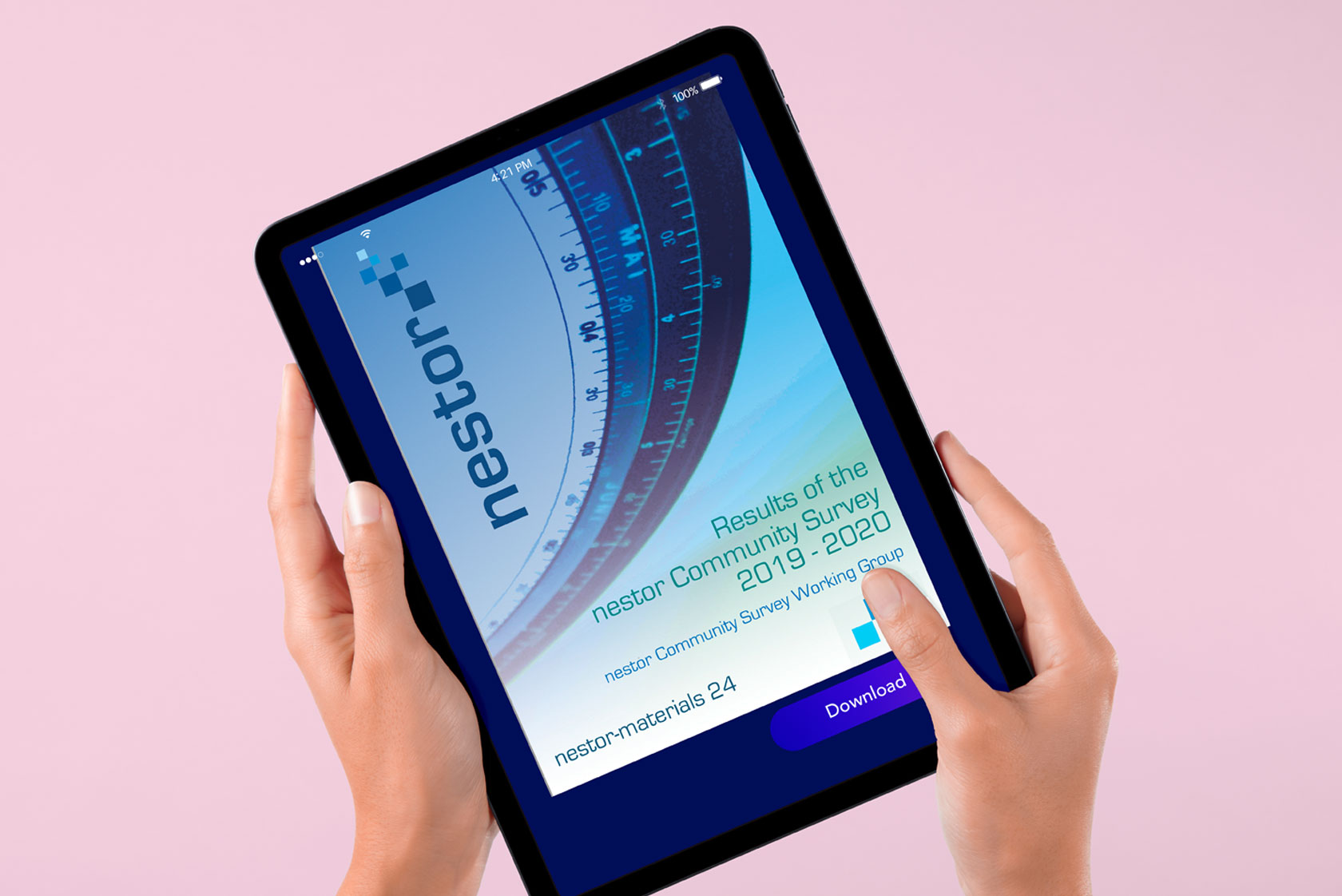
Digital Long-term Archiving: Discovering Networks With the nestor Community Survey
nestor, the competence network for digital long-term archiving, recently conducted a survey among national and international digital preservation communities and published the results as a community survey. In addition to the anonymous evaluation of the collected data, a series of community profiles also emerged from the survey. In this guest article, three members of the responsible working group present some of the interesting results of the survey.
Guest article by Svenia Pohlkamp, Stefan Strathmann and Monika Zarnitz
![]()
The idea of the nestor community survey
Digital preservation is a task that is complicated and resource-intensive. Cooperation, communication and mutual support is necessary to cope with the different challenges of this matter. nestor is active in all these areas.
That`s why the idea emerged to start a survey among the national and international communities that cope with digital preservation. nestor installed a small working group that developed the questionnaire and analysed the result of the community survey. The aim of this survey is to create transparency about the international landscape of communities in this field and to collect information for all those who wish to collaborate.
The questionnaire for the survey, which was conducted online, consisted of 40 questions. We gathered 54 valid answers as basis for our analysis.
The nestor community survey
The survey distributed through multiple channels, such as mailing lists, direct contact to colleagues and so on from autumn 2019 until May 2020. The results of the survey were evaluated, edited and published in 2022 in the series of nestor materials.
Besides this publication, another result of the survey was the development of so-called community profiles, which you can find on nestor’s website. These profiles are self-descriptions of the involved communities and may serve as a sort of registry of national and international communities. They provide the first ever overview of the various facets, resources and focal areas of long-term archiving networks worldwide. The aim is to improve transparency and facilitate cooperation of the different communities worldwide.
Of the 54 participants who completed the questionnaire in full, 32 have so far allowed us to publish their community profile. We hope that more will give their consent. The communities had the opportunity to update and/or correct their data while reviewing their profiles.
What is a community?
One basic decision during the project was how to define and circumscribe the term “community” in the context of the survey, since there are manifold possibilities to define a community and it should be fitting to our object of investigation. Following intensive discussion, the working group agreed on the following definition:
- An open community of persons and/or institutions that engages with the subject of long-term archiving. Digital long-term archiving can be one of several topics, which the community deals with.
- A community whose members are committed to digital long-term archiving in a manner that goes beyond pure self-interest. Its central or sole purpose is not to supply a product or provide a commercial service.
- A platform for discussing the topic of digital long-term archiving and its advancement, including the development of tools and/or the provision of services.
- It can be local, regional or international.
- It does not matter how big the community is. It can be large or small.
- Whether the community is product-related or not is also irrelevant.
- In the following paragraphs, we present some selected results of the survey.
Digital preservation communities: Where are they situated?
In question 6 we asked in which country or part of the world the community is located. Several communities mentioned more than one country in the text entry field. We chose either the country where they are based or the first country they mentioned.
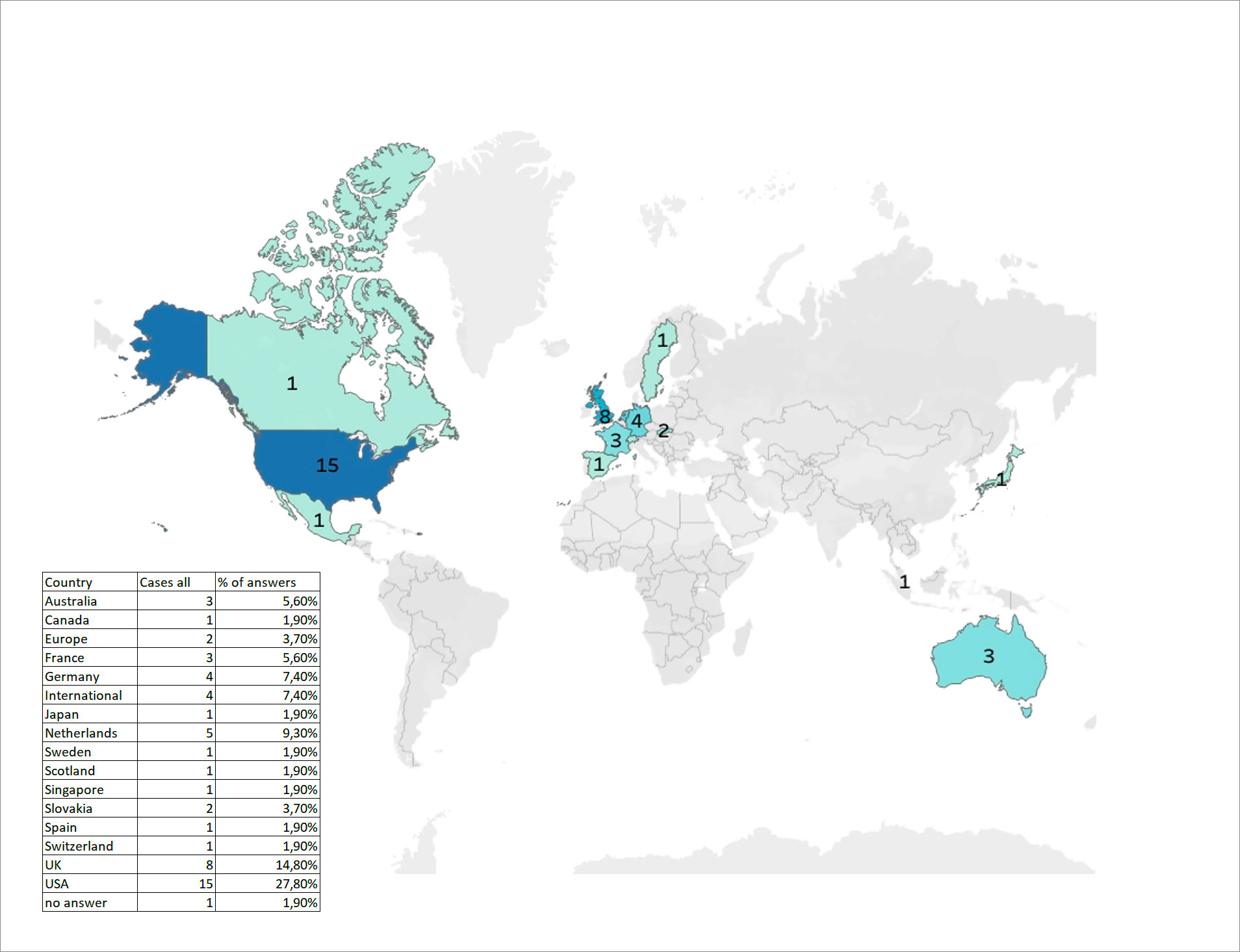
Digital preservation communities: Where are they situated?
Interpretation: Almost all communities represented in this survey are situated in industrial countries. Either we couldn’t reach out to the communities in other countries or there are very few digital preservation communities in the developing and less-developed countries. This may be due to the lack of resources, and shows that in the most countries there is either few digital preservation activity or the actors in this field do not have the resources to join a community and benefit from the exchange with colleagues in other countries. The latter aspect may be not so important because communities increasingly communicate digitally and there is abundant literature and software freely accessible in the web.
Digital preservation communities: Are they silos or do they cooperate with each other?
In question 25, we asked how many cooperations with other communities the participating communities currently have. Four check boxes were provided. Only one answer could be given.
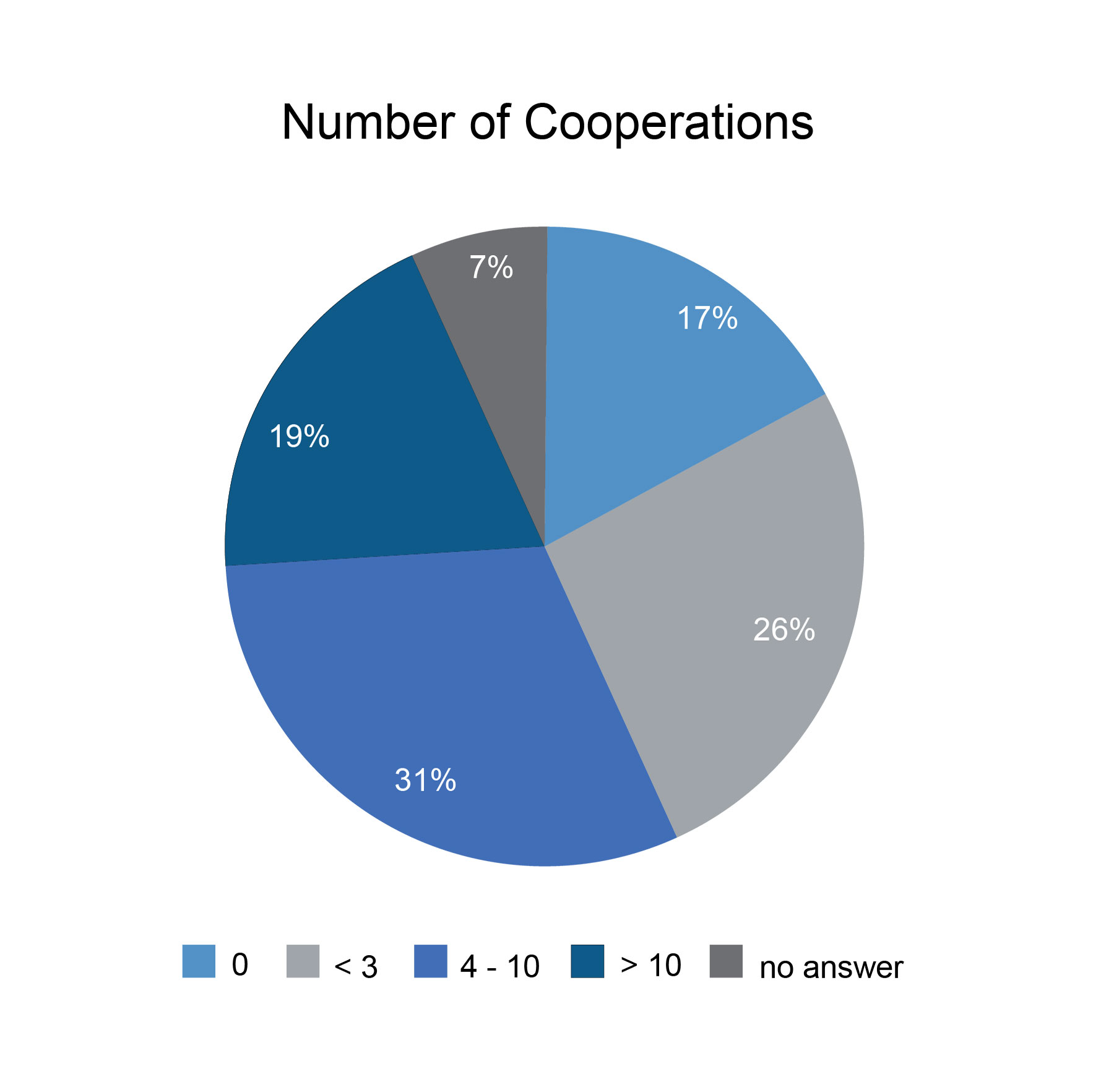
Percentage of cooperations
Interpretation: Our data shows clearly, that communities are no silos and that they interact with other communities intensively. Only 17 % of the communities do not have a cooperation with another community, while 19 % of them cooperate with more than ten other communities. Institutions and persons who engage in digital preservation are often members of several communities, so there is a broad exchange of ideas, tools, publications and other results of community work. Digital preservation is a task too complicated to tackle on one’s own and this not only on the individual level but at the level of communities as well. This may be the reason for the intensive exchange between the communities.
Digital preservation communities: What kind of organisation are they and what kind of finance do they use?
In question 11, we enquired how the communities are organised. The majority of 93 % stated to be non-profit organisations. In question 14, we asked how the communities finance themselves and their work. Six check boxes were provided. Multiple answers were possible. The sixth check box was “Other” with a text entry field.
The entries for “Other” have been re-categorised and are shown in the table below alongside the five given response options. The entries re-categorised and reassigned in “Other” are displayed in italics.
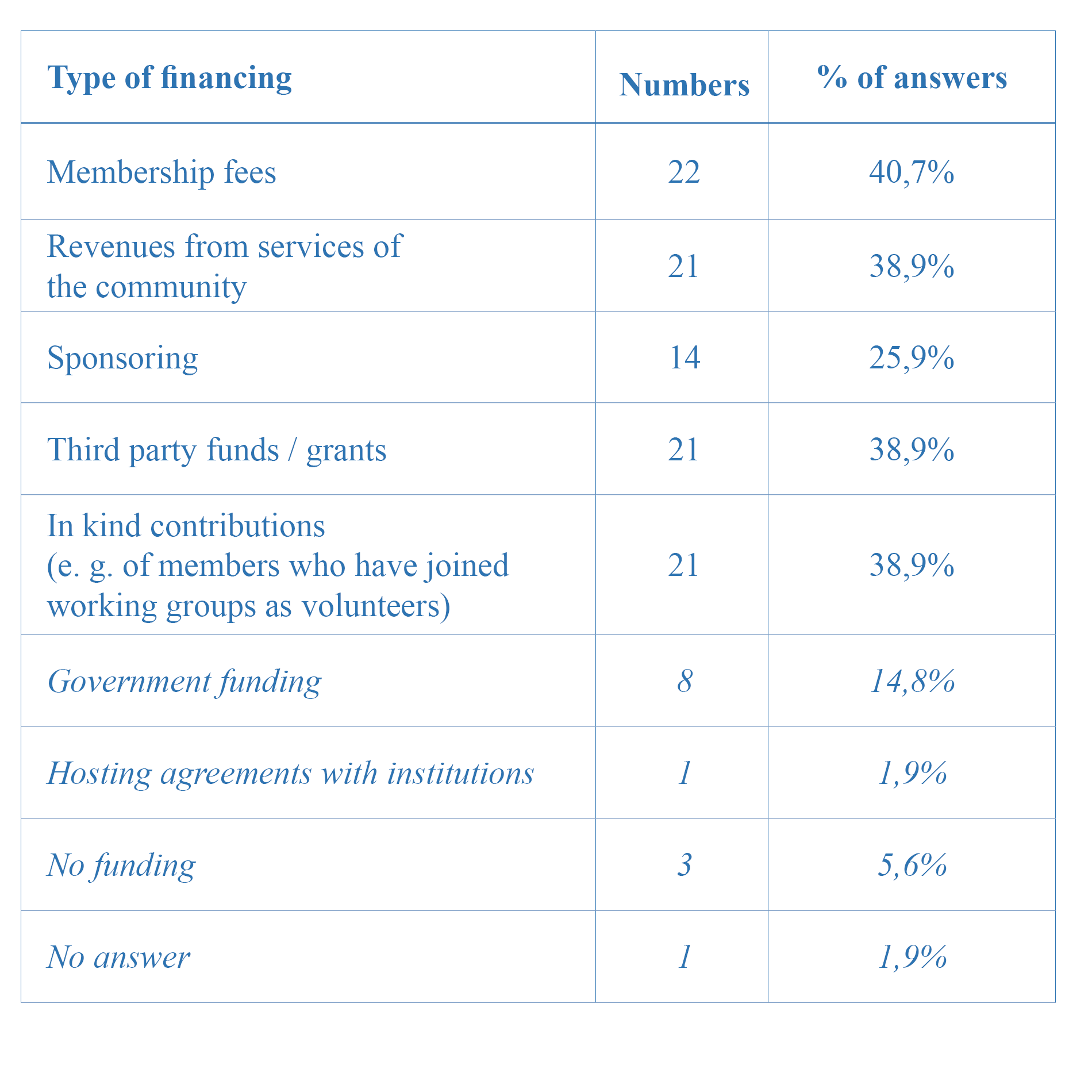
Digital preservation communities: What kind of organisation are they and what kind of finance do they use?
Interpretation: This table shows that the main sources of finance are membership fees, revenues from services, sponsoring, third party fund / grants and in kind contributions. None of the other sources has a comparable importance for financing. This, together with the fact that communities are mainly non-profit organisations (see above), shows that digital preservation has no commercial aims and that the self-conception of these organisations is comparable to the self-conception of libraries, archives and museums as heritage organisations. Indeed, the persons active in the communities originate from organisations such as these and carry the same mentality into the communities.
Digital preservation communities: What makes a community successful?
In question 40 we asked about the most important success factors of the community. Participants often entered several options into the text fields. This means, there were many different answers to this question. For this reason, we assigned the answers given in the text entry fields to different categories (where possible) and displayed them in a word cloud. It contains all the categorised answers as well as those for which no category was found.
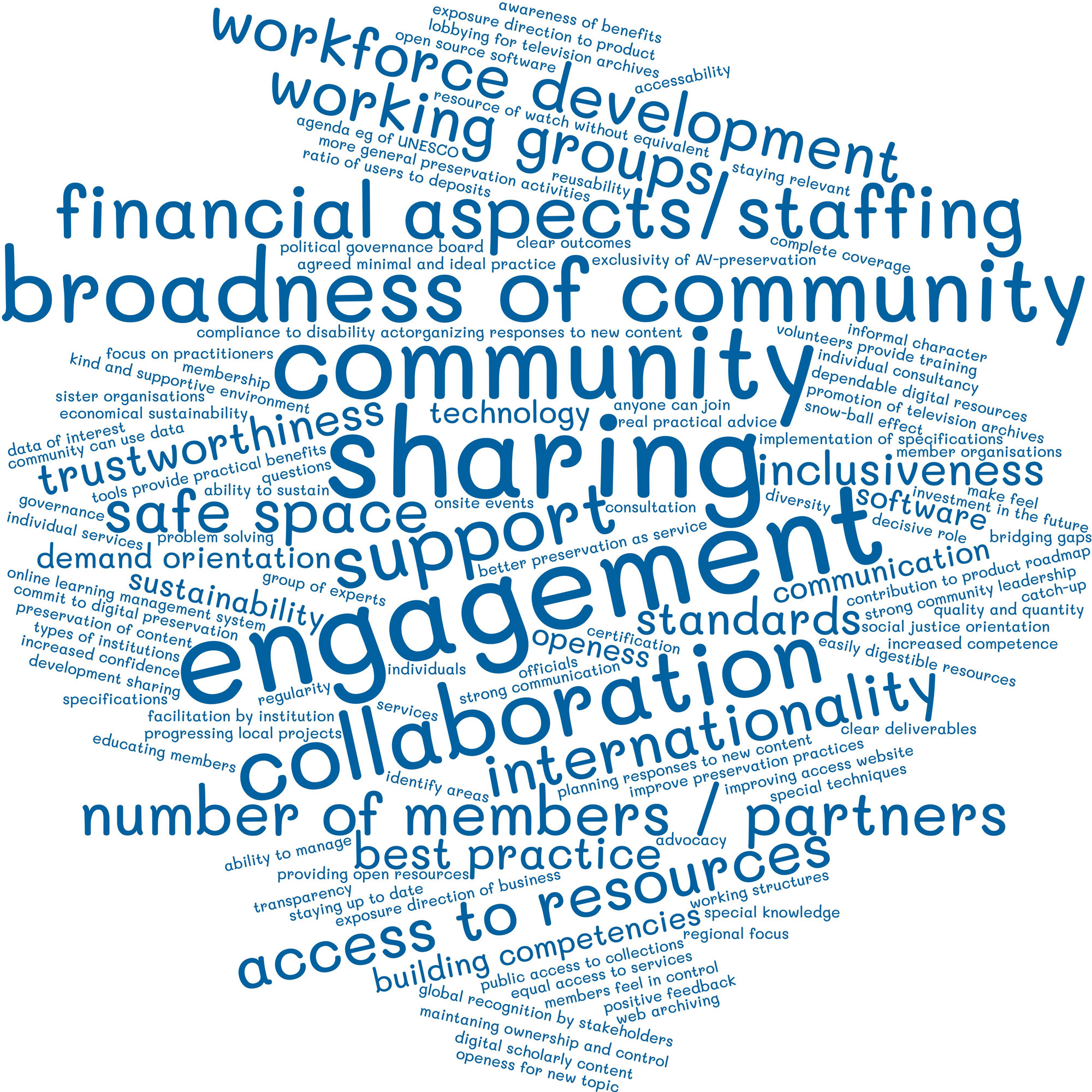
This word cloud contains all the categorised answers as well as those for which no category was found.
Interpretation: This word cloud shows the most important aspects for the success of a digital preservation community. Three aspects are particularly significant:
- Critical success factors are the engagement, the collaboration and the sharing of knowledge and resources.
- Communities support the creation of knowledge and technologies for digital preservation.
- The broadness of a community is important since there are so many details in digital preservation that the manifoldness of competencies and perspectives is necessary..
Conclusion on digital preservation communities
The nestor community survey offers a rich source of data that explains the behaviour of digital preservation communities. The cases we picked up in this blog post show that the communities cluster in industrial countries and that they are in close contact and interaction with each other on several levels (the communities themselves, individual members, institutions, persons). The institutions that are parts of the communities are mainly non-profit organisations with the typical sources of finance and the typical mentality of heritage organisations.
Repetition in 2023
We would like to repeat the survey in 2023 and hope to improve it with our experiences from the first run. We aim at reducing the time between the beginning of the next survey and the date of publication of the results and we will reformulate some questions so that they are clearer and the evaluation is easier. We hope that with the publication of the first survey there may be more awareness for the second round and that then more communities participate.
We invite all communities that are active in the field of digital preservation to suggest improvements of the survey and to take part in its upcoming repetition. If you are interested in participating, please contact us:
This might also interest you:
- Website of the nestor network (partly only German)
- nestor CommunityProfiles
- nestor onTwitter
- nestor on YouTube
- Results of the Community Survey 2019 – 2020
- The Long-term Perspective … nestor – Competence Network for Long-term Digital Preservation and Availability of Digital Resources (German)
- Open Preservation Foundation, 2019-20 Digital Preservation Community Survey. Surveys
Svenia Pohlkampworks at the German National Library (DNB) and manages the nestor office there. She is responsible for the coordination between nestor’s partners and organisational matters of the network. She also takes part in two of nestor’s working groups, Community Survey and Certification.
Stefan Strathmann works at the Göttingen State and University Library (SUB) in the Digital Library Department. He is responsible for SUB’s activities in the area of digital preservation. In particular, he represents the SUB at nestor, the German national network of excellence in digital preservation.
Dr Monika Zarnitz is an economist and head of the Programme Area User Services & Collection Care at the ZBW – Leibniz Information Centre for Economics. She is head of the nestor working group „Community Survey“.
Portrait Monika Zarnitz: Fotograf: Sven Wied, ZBW©
View Comments

Social Media in Libraries: Best Practice From the Austrian National Library
Tens of thousands of followers on Facebook, impressive community engagement on...



